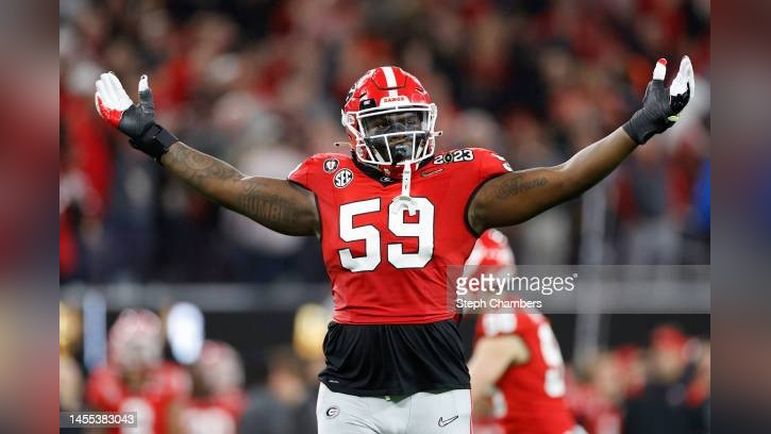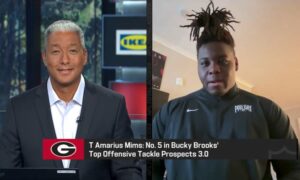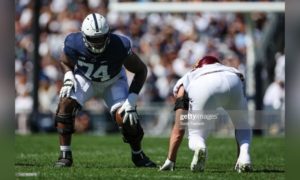Let’s go back in time. To late February. To Aaron Rodgers.
In a completely dark room.
That was Rodgers’ now famous (or infamous) “darkness retreat” where he contemplated his future move. Stay in Green Bay? Go somewhere else? Retire?
Ultimately, Rodgers no longer wanted to be a Packer. Which, after quite some time, made him a New York Jet. Though it may sound crazy on its surface, I’ll tell you what life would’ve looked like had Rodgers never made his way to 1 Jets Drive. I can’t tell you everything that would’ve occurred. But I know one thing.
Broderick Jones isn’t a Steeler.
Believe it or not, those two names and their career arcs are intertwined, the 39-year old Rodgers and the 21-year old Jones. Here’s why. As part of the Rodgers’ deal to the Jets, Green Bay and New York swapped first-round picks, #13 and #15. Before the trade, the meat of the draft order most relevant to Pittsburgh looked like:
13. New York
14. New England
15. Green Bay
16. Washington
17. Pittsburgh
The Packers sent #15 while the Jets gave them back #13, making the post-trade order:
13. Green Bay
14. New England
15. New York
16. Washington
17. Pittsburgh
It’s only two spots but a crucial difference. It was no secret that the Jets and Steelers were targeting offensive tackles. Paris Johnson was going to be gone before either team selected, and he ended up going 6th overall to Arizona. Darnell Wright went off the board at #10 and Peter Skoronski 11th, a pretty noticeable run of the top offensive linemen. It left Jones as the remaining prize. Throughout the pre-draft process, the Jets were considered the favorite to take him with Jets beat writer Rich Cimini strongly hinting Jones would be the target is available (this tweet hours before the Rodgers trade).
The Steelers recognized that and once the o-line run happened, they jumped the Jets at 15 by trading with the Patriots at 14, sending a 4th-round pick (#120 overall) to do so. The Jets ended up drafting Iowa State EDGE Will McDonald.
So what if the Jets had stayed at 13? Pittsburgh jumping them would have been much tougher. Here’s what we know.
– The Jets were targeting Jones at #13
– The Steelers didn’t want to send a Day Two pick in any potential trade-up
Mike Tomlin admitted the latter in his post-pick conference, telling reporters:
“We weren’t wiling to mortgage above a third day pick. [Jones] got within range.”
And here’s what we can infer:
– Pittsburgh probably would’ve had to move to #11 to jump the Jets
We know the Jets wanted Jones. And #12 was a trade hotspot with the Houston Texans moving up from #12 to #3 with Arizona to grab Will Anderson while the Cardinals soon after moved up from #12 to #6 to take Paris Johnson. They traded back with the Detroit Lions, who surprised many by selecting RB Jahmyr Gibbs. Reportedly, the New England Patriots also wanted Gibbs, and knowing the Lions already moved back once, they weren’t going to move back again. Meaning, trading up to #12 wouldn’t have been possible and #11 with the Tennessee Titans was the next logical destination.
Would a 4th-round pick have been enough to land Tennessee’s 11th overall pick? We can’t answer that with certainty but it’s doubtful. Trade charts vary but according to this commonly used one, the difference between picks 11 and 17 is 300 points. Pittsburgh’s 120th pick was worth only 54 points which on paper isn’t nearly enough. To be fair, the same chart also shows that trading #120 for #14 also isn’t enough but it’s much closer, the Pats lost their target in Gibbs, and Bill Belichick got to screw an AFC East rival at the same time. Everyone wins. Except the Jets.
Long story short. Had the Jets stayed at #13, the Steelers would not have been willing to give up the draft capital necessary to get ahead of them. Meaning the Jets take Jones and all the top tackles are gone. And unless Pittsburgh was willing to take Oklahoma OT Anton Harrison at #17, the entire complexion of their draft changes. Instead of a tackle, they almost certainly go corner, choosing between Maryland’s Deonte Banks and Penn State’s Joey Porter Jr.
Knowing they would’ve gotten their corner at 17, the Steelers probably trade out of #32. No longer have they taken a tackle with a corner like Porter staring them in the face, and the offers they got were, as Omar Khan admitted, “strong.” So they trade out of 32, probably with the Tennessee Titans, and pick up #41 overall, a third-round pick, and a 2024 third. That’s what the Titans gave the Cardinals for the 33rd pick.
And from there, who knows how the draft goes. The Steelers probably still land some of the players they drafted: DL Keeanu Benton, TE Darnell Washington, etc. But there would’ve been more picks, there would’ve been different picks, and a domino effect that would’ve changed everything. Dan Moore would’ve been the clear-cut starter entering the fall.
That’s what the Rodgers deal did. It certainly changed those franchises. Green Bay embarking on the Jordan Love era. New York getting its best quarterback since Joe Namath. But it also had a direct impact on Pittsburgh and Khan’s first draft class, with the Steelers taking their first offensive tackle in Round One in nearly 30 years. And in the process, changing the rest of their draft.








